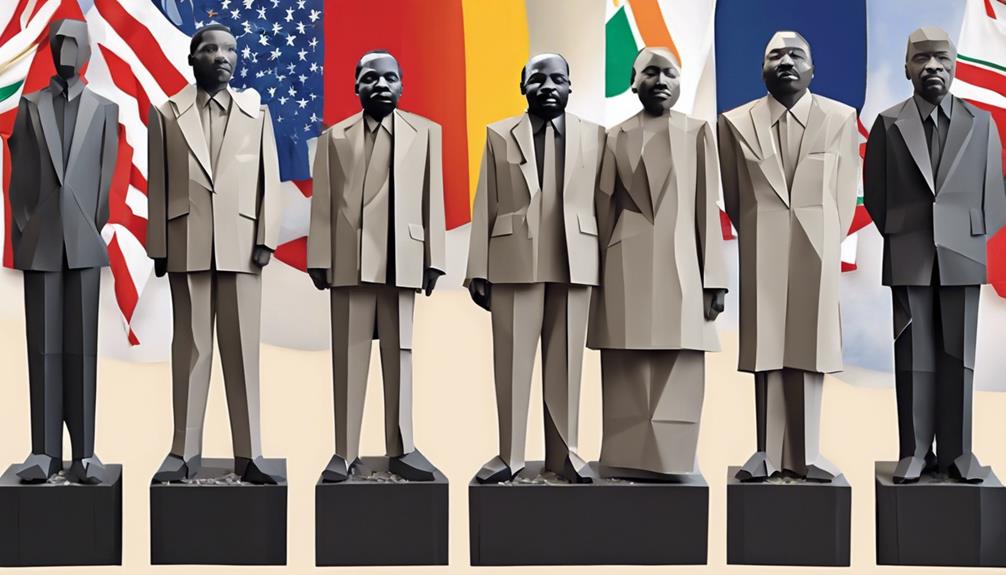You're curious about the famous people whose speeches have left an indelible mark on history. From Martin Luther King Jr.'s "I Have a Dream" to Winston Churchill's "We Shall Fight on the Beaches", these iconic voices have inspired generations to fight for freedom, equality, and human rights. Patrick Henry's "Give Me Liberty or Give Me Death" fueled the American Revolution, while Nelson Mandela's speeches fought against apartheid in South Africa. These legendary figures have shaped the course of human history, and their speeches continue to empower people today. As you explore these extraordinary speeches, you'll uncover the secrets behind their lasting impact.
Key Takeaways
- Iconic speeches like Martin Luther King Jr.'s 'I Have a Dream' and Winston Churchill's 'We Shall Fight on the Beaches' have shaped the course of history.
- Rhetorical devices like anaphora, metaphors, and repetition make speeches memorable and impactful, inspiring generations to come.
- Famous speeches have fueled movements for freedom, democracy, and human rights, leaving an indelible mark on humanity.
- The context and timing of iconic speeches, such as Queen Elizabeth I's speech at Tilbury, have fortified troops and inspired collective action.
- Studying famous speeches provides insights into the techniques used by iconic speakers, revealing secrets of effective oratory and its enduring impact.
Iconic Voices for Change
Throughout history, iconic voices have propelled movements and inspired nations, and you're about to discover the most influential speeches that sparked lasting change.
One of the greatest examples is Martin Luther King's 'I Have a Dream' speech, which ignited the civil rights movement in 1963.
Another iconic voice is Patrick Henry's, whose 'Give Me Liberty or Give Me Death' speech in 1775 fueled the American Revolution's spirit of independence.
These great speeches in American history have left an indelible mark on our collective consciousness.
You can also add Winston Churchill's 'We Shall Fight on the Beaches' speech to the list, which rallied Britain's resolve during WWII.
More recent examples include Barack Obama's and Nelson Mandela's powerful orations, which inspired hope and unity.
These iconic voices have changed the course of history, and their words continue to inspire us today.
As you explore these speeches, you'll discover the power of the human voice to shape our world and create lasting change.
Foundations of Oratory Excellence

By mastering the art of crafting powerful speeches with memorable hooks and clear subpoints, you can harness the transformative power of oratory excellence to shape history. The foundations of oratory excellence lie in understanding the key elements that make a speech unforgettable.
- Rhetorical devices, such as anaphora, create a memorable rhythm that leaves an indelible mark on history.
- Historical documents and speeches serve as a blueprint for modern civilizations, offering valuable insights into the context and techniques used by iconic speakers.
- By studying the words and techniques of famous speeches, you can grasp their essence and impact on society, inspiring change and shaping the course of history.
As you explore the world of oratory excellence, remember that it's not just about crafting powerful speeches, but also about understanding the context in which they were delivered. By doing so, you'll reveal the secrets of iconic speeches and be well on your way to making your own mark on history.
Historical Speeches That Inspired

You've likely heard echoes of iconic speeches that have shaped the course of history, inspiring generations to pursue freedom, equality, and justice. These historical speeches have left an indelible mark on history, motivating people to take action and fight for their rights.
Martin Luther King Jr.'s 'I Have a Dream' speech in 1963 is a prime example, advocating for racial equality and civil rights. Similarly, Winston Churchill's 'We Shall Fight on the Beaches' speech in 1940 inspired British resilience during WWII. Queen Elizabeth I's speech at Tilbury in 1588 fortified her troops against the Spanish Armada, while Ronald Reagan's 'Tear down this wall' speech in 1987 urged the removal of the Berlin Wall, symbolizing the end of the Cold War.
Patrick Henry's 'Give Me Liberty or Give Me Death' speech in 1775 ignited revolutionary fervor in America. These speeches have inspired people to stand up for their rights, sparking movements and shaping the course of history. They continue to inspire us today, reminding us of the power of words to create change and leave a lasting impact.
War, Peace, and Social Justice

As the world grapples with conflicts, inequalities, and social injustices, powerful orations have consistently motivated humanity to pursue peace, justice, and equality. You've likely heard iconic speeches that have shaped history, inspiring leaders and everyday people to advocate for what's right.
Some of the most influential speeches have been made during times of war, peace, and social unrest. For instance:
- Winston Churchill's 'We Shall Fight on the Beaches' speech rallied Britain during World War II, showcasing resilience in the face of adversity.
- Martin Luther King Jr.'s 'I Have a Dream' speech inspired the pursuit of equality and civil rights for all Americans.
- Nelson Mandela's speeches, like his Rivonia Trial speech, fueled the fight against apartheid and called for justice and reconciliation in South Africa.
These speeches have left an indelible mark on history, inspiring generations to work towards peace, social justice, and equality. They demonstrate the power of words to spark change and promote human rights.
Champions of Human Rights

Beyond the world of war and social unrest, there exist individuals who've dedicated their lives to fighting for the rights and dignity of all people, championing the cause of human rights with unwavering passion and conviction.
You're likely familiar with Martin Luther King Jr.'s iconic 'I Have a Dream' speech, which advocated for racial equality and civil rights for all. Similarly, Nelson Mandela's 'I Am Prepared to Die' speech inspired South Africans to end apartheid and embrace democracy.
Eleanor Roosevelt's address on the Universal Declaration of Human Rights laid the foundation for global human rights standards, promoting dignity and respect for all individuals. Sojourner Truth's powerful 'Ain't I a Woman?' speech highlighted the struggles of Black women facing racism and sexism.
These champions of human rights have made a lasting impact, inspiring generations to fight for a more just and equal world. Their speeches serve as a reminder of the power of the human voice to bring about change and promote human dignity.
Speeches That Shaped Nations

As you explore the world of speeches that shaped nations, you'll discover how iconic figures harnessed the power of words to rally their people. You'll see how their impassioned calls to action, like Abraham Lincoln's Gettysburg Address, inspired freedom and democracy during times of turmoil.
Now, let's explore how speeches like these ignited a sense of unity and purpose, calling people to stand together in the face of adversity.
Freedom's Call to Action
Throughout history, powerful orations have inspired nations to take a stand against oppression, and you're about to discover the most influential speeches that fueled the fight for freedom.
These iconic speeches have ignited a sense of urgency, calling people to action against racial discrimination, inequality, and tyranny. They've inspired generations to aspire for civil rights, equality, and democracy.
Some of the most notable examples include:
- Abraham Lincoln's Gettysburg Address, which reinforced the ideals of freedom and democracy during the Civil War.
- Martin Luther King Jr.'s 'I Have a Dream' speech, which inspired a generation to advocate for civil rights and equality.
- Winston Churchill's 'We Shall Fight on the Beaches' speech, which rallied Britain against Nazi aggression during WWII.
These powerful calls to action have left an indelible mark on history, shaping the course of nations and inspiring people to fight for their freedom.
Unity in Dark Times
In the darkest of times, when nations teetered on the brink of collapse, iconic leaders stepped forward to rally their people with impassioned speeches that forged unity and inspired resilience. You, as a citizen, crave inspiration and guidance during crisis, and these leaders delivered. Their words became a rallying cry, igniting the flame of hope and strengthening the bonds of unity.
| Leader | Speech | Impact |
|---|---|---|
| Winston Churchill | We Shall Fight on the Beaches | Rallied Britain during WWII |
| Queen Elizabeth I | Tilbury Speech | Fortified troops against the Spanish Armada |
| Abraham Lincoln | Gettysburg Address | Reinforced democracy and equality |
| Martin Luther King Jr. | I Have a Dream | Inspired the Civil Rights Movement |
| Ronald Reagan | Brandenburg Gate Speech | Demanded the removal of the Berlin Wall |
These leaders embodied the values of democracy, equality, and freedom, guiding their nations through dark times. Their speeches showcased remarkable leadership, highlighting the importance of unity in the face of crisis. As you reflect on these iconic speeches, remember that they continue to inspire and guide us, even in today's turbulent times.
Oratory in Times of Turmoil

As you explore the world of oratory in times of turmoil, you'll discover that crises have a way of sparking powerful speeches that call for action and give voice to the voiceless.
From Winston Churchill's defiant rallying cry during World War II to Martin Luther King Jr.'s impassioned plea for equality, these speeches have become beacons of hope in the darkest of times.
As you navigate this turbulent landscape, you'll uncover the ways in which crisis can catalyze courageous leadership and inspire collective action.
Crisis Calls for Action
When crisis calls, great leaders rise to the challenge, using their oratory skills to rally their people and inspire them to take action. In times of turmoil, their speeches become beacons of hope, guiding their audience toward a brighter future.
You've likely heard of some of these iconic speeches that have left an indelible mark on history. They're the ones that inspire change, spark action, and ignite a sense of purpose.
Some notable examples include:
- Winston Churchill's 'We Shall Fight on the Beaches' speech, which rallied Britain during World War II's darkest hour.
- Queen Elizabeth I's speech at Tilbury, which fortified English troops against the Spanish Armada's threat.
- Patrick Henry's 'Give Me Liberty or Give Me Death' speech, which ignited the American Revolution with its call for freedom.
These impactful speeches showcase the importance of leadership, inspiring change, and motivational oratory. In times of crisis, they become a call to action, urging people to take a stand and fight for what's important.
Voices for the Voiceless
Through the power of oratory, courageous individuals have stepped forward to amplify the voices of the marginalized, inspiring collective action against injustice and oppression.
You've likely heard of Martin Luther King Jr.'s iconic 'I Have a Dream' speech, which resonated deeply with the civil rights movement, advocating for racial equality and leaving a lasting impact.
Similarly, Malala Yousafzai's UN speech in 2013 emphasized the importance of education for girls, sparking a global call to action for change.
In times of turmoil, voices like these have been beacons of hope, inspiring leadership and freedom.
You may recall Winston Churchill's rousing WWII speeches, like 'We Shall Fight on the Beaches,' which rallied Britain's resilience against Nazi aggression.
Even Queen Elizabeth I's speech at Tilbury fortified her troops' resolve against the Spanish Armada, showcasing her leadership in times of crisis.
Patrick Henry's 'Give Me Liberty or Give Me Death' speech, meanwhile, ignited the American Revolution with its passionate call for independence.
These speeches demonstrate the profound impact one voice can have, inspiring you to use your own voice for positive change.
Lasting Impact on Humanity

From Martin Luther King Jr.'s impassioned cry for racial equality to Nelson Mandela's defiant stance against apartheid, history's most influential speeches have left an indelible mark on humanity. You've likely heard these iconic speeches, but have you ever stopped to think about the lasting impact they've had on human history? These speeches have inspired movements, shaped democracy, and brought people together in the fight for justice and equality.
Here are just a few examples of the lasting impact of these speeches:
- They've inspired generations to fight for freedom and democracy, from the Civil Rights Movement to the end of the Cold War.
- They've reinforced the principles of justice and equality, shaping the course of human history.
- They've given voice to the voiceless, empowering marginalized communities to demand their rights and challenge oppressive regimes.
These speeches have changed the course of human history, leaving a lasting impact on humanity that continues to inspire and empower people today.
Frequently Asked Questions
What Is the Most Famous Speech in History?
You're wondering what the most famous speech in history is, right? It's a tough call, but many would argue it's Martin Luther King Jr.'s 'I Have a Dream' speech, which still resonates deeply with people today.
What Historical Figure Whose Speech Impacted the World?
You're wondering which historical figure's speech had a profound impact on the world. In your quest for an answer, you might consider leaders who inspired nations, fought for equality, or stood against oppression.
What Is the Most Inspiring Speech of All Time?
You're wondering what the most inspiring speech of all time is – for you, it's likely a message that resonates deeply, sparks hope, and fuels your passions. Maybe it's a call to action, a beacon of hope, or a powerful declaration of human rights.
What Famous Speeches Are Relevant Today?
As you navigate life's turbulence, you're likely searching for beacons of hope. You're wondering which famous speeches remain relevant today, and the answer is clear: those that ignite passion, fuel resilience, and whisper truth to power still resonate deeply.
What Was the Impact of the Speeches Given by Famous Public Speakers on History?
The speeches given by famous public speakers shaped world events and inspired change throughout history. Leaders like Martin Luther King Jr., Winston Churchill, and Nelson Mandela used their words to ignite social movements, advocate for equality, and challenge oppressive systems. The impact of these speeches continues to resonate in our world today.
Conclusion
As you reflect on the iconic voices that have shaped history, remember that their words weren't just spoken, but lived. They ignited fires of change, fueled by passion and conviction.
Their oratory excellence inspired generations, just as their messages of war, peace, and social justice continue to reverberate. These champions of human rights showed us that speeches can be powerful catalysts for progress, leaving an indelible mark on humanity.










